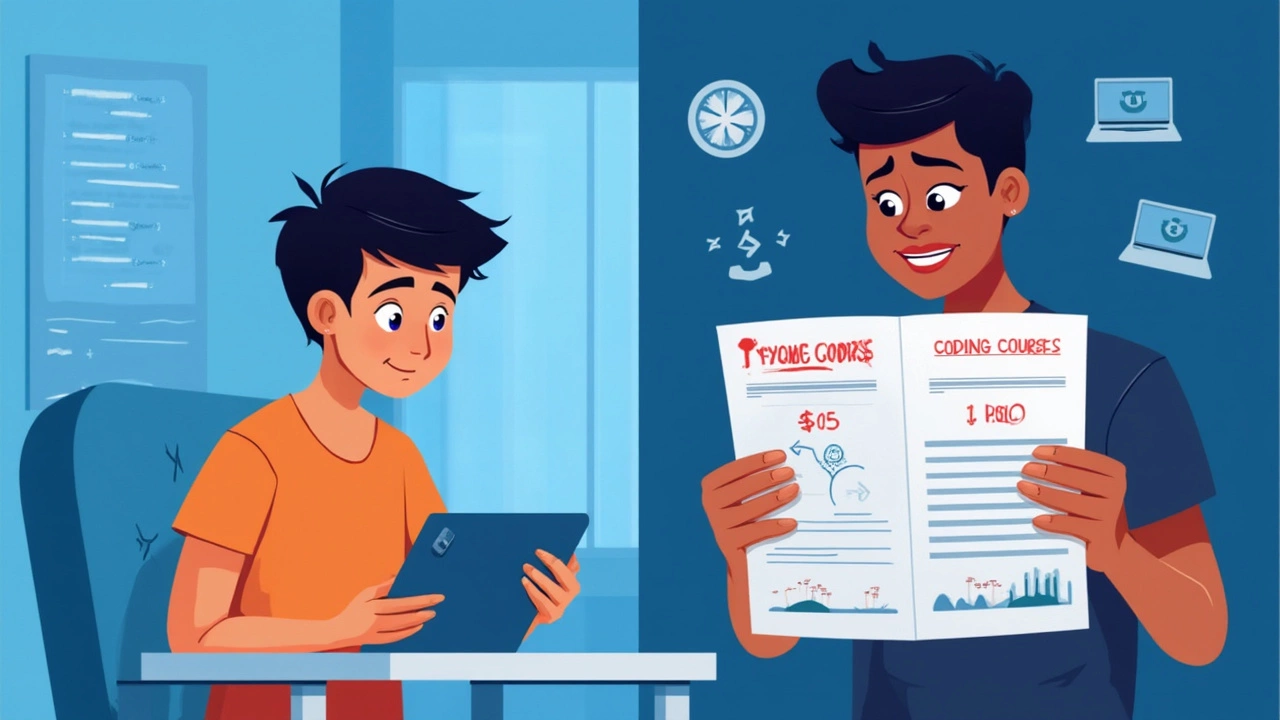Planning to start coding but worried about breaking the bank? You’re not alone. The prices for coding classes are all over the place—some are totally free, others have you shelling out more than you’d spend on a small car. There’s no one-size-fits-all answer, but it helps to know what you’re paying for and what actually moves the needle when you’re trying to learn.
If you’re just starting out, free lessons sound awesome—but are they really enough to get you job-ready? And what’s the deal with those $15 month-long subscriptions versus $15,000 bootcamps? Trust me, these price tags aren’t always linked to results. Turns out, picking the right class is about more than dollars and cents—you want to find something that fits your pace, your learning style, and your real-life goals.
The coding world is packed with choices. From YouTube tutorials and kid-friendly coding clubs to hands-on bootcamps that promise a tech job by the end—there’s a lot to weigh. Fees can sneak up on you, too, with some courses charging extra for “certificates” or “career coaching” that just mean email templates.
I’ve seen folks overpay for shiny platforms and others hack their way to solid skills for the cost of a few pizzas a month. If you’re serious but don’t want to waste cash, it pays to know exactly what’s out there and what to look for before you grab that credit card. Let’s break down each option and trade secret so you don’t get stuck paying more than you need to.
- Free Coding Classes: Worth It or Not?
- Low-Cost Online Programs and Subscriptions
- Bootcamps and Premium Courses: Paying Top Dollar
- Hidden Fees and What’s Included (or Not)
- Tips for Getting Value Without Wasting Money
Free Coding Classes: Worth It or Not?
The first thing everyone thinks about when picking up coding is, “Why pay when you can learn for free?” There are tons of no-cost options, but are they actually good enough for real results? Let’s break down what you’re really getting—and missing—when you choose free coding classes.
Here’s something wild: platforms like freeCodeCamp and Khan Academy have helped millions learn programming basics since 2015. Even Google says that more than 40% of coders in its recent developer surveys used free materials as their main resource.
Here’s a quick look at popular free coding platforms and what they offer:
| Platform | Main Features | Best For |
|---|---|---|
| freeCodeCamp | Hands-on projects, certifications, big community | Web dev beginners, resume builders |
| Khan Academy | Interactive lessons, video walk-throughs | Total newbies, school students |
| Codecademy (free tier) | Basic coding courses in several languages | Absolute beginners |
| Coursera (audit mode) | University-quality intro classes, no certificate | Self-motivated learners |
| YouTube | Massive library, shared by working devs | People who learn visually/hands-on |
But let’s get real: while free resources are perfect for exploring programming, most of them don’t go deep. Structure can be all over the place and there’s basically no personal support if you get stuck. Some people thrive on trying things solo, but others end up frustrated, lost, and giving up right before things start making sense.
- If your main goal is to get a coding classes certificate for job hunting, free options alone might not cut it. Most places (yeah, even freeCodeCamp) don’t offer anything that really gets noticed by employers.
- Want interaction? You might have to hunt through forums and Discord servers for help, which isn’t everyone’s idea of a good time.
- Ready to push past the basics? That’s where most free content fizzles out, unless you’re super disciplined and like building your own study path from scratch.
My wife Priya once tried to learn Python using nothing but YouTube and free exercises. She picked up the basics but hit a wall with more complicated stuff—there just wasn’t enough feedback or guidance. If you’re naturally curious and independent, free stuff can absolutely get you started. But if you want a clear, step-by-step path to a job or big project, you’ll probably end up looking at paid options at some point.
Low-Cost Online Programs and Subscriptions
Not everyone has cash to blow on expensive bootcamps. That’s where low-cost coding classes come in. These programs live online and are easy to sign up for, so you can start learning code right after dinner if you want. The best part? Most of them won’t cost more than your streaming apps each month.
Some of the most popular spots are Codecademy, Udemy, freeCodeCamp, LinkedIn Learning, and Coursera. Codecademy's paid Pro plan runs about $40 per month, but you can get deals if you pay yearly. Udemy often lists courses at $10–$20 during sales, though the sticker price looks way higher (nobody actually pays the $200+ price, trust me). Coursera and LinkedIn Learning go for around $40 a month, but offer free trials to get you started.
Here’s a quick look at common costs for coding classes on these popular sites:
| Platform | Monthly Cost | Notable Features |
|---|---|---|
| Codecademy Pro | $40 | Guided paths, real projects, instant feedback |
| Udemy | $10–$20 per course (on sale) | Pay per class, lifetime access, huge variety |
| Coursera | $39–$49 | University-backed, certificates, sometimes free to audit |
| LinkedIn Learning | $39 | Business and tech focus, badges, trial period |
| freeCodeCamp | $0 | Completely free, tons of practice projects |
The cool thing about these online providers is you can mix and match. Maybe start free on freeCodeCamp until you get the hang of it, then jump into a paid path if you want to go deeper or get a certificate for your resume. Many of these platforms also run on subscriptions, so you can cancel anytime—no need to lock yourself into a year-long commitment if you realize it’s not your thing.
Some tips to get more out of these courses:
- Sign up during sales—Udemy always has discounts, so don’t ever pay full price.
- Check for student or educator discounts on sites like Codecademy and Coursera.
- Use free trials to test out the platform before paying. Most offer at least 7 days without a credit card charge.
- Read reviews about the instructor and content before you buy—some courses are way more useful than others.
One thing to remember: these subscriptions often give access to hundreds (sometimes thousands) of courses, so make a learning plan or you’ll get overwhelmed. Stick to one language or topic at first, like Python or web development. Focused effort pays off more than skimming dozens of unrelated videos.

Bootcamps and Premium Courses: Paying Top Dollar
When people ask what makes coding classes so expensive, it’s usually bootcamps and big-name premium courses tipping the scales. Bootcamps are like coding’s high-speed trains—they cram loads of hands-on projects, live instruction, and job coaching into a few months. The upshot? They cost way more than self-paced online courses. If you’re going this route, you’ll want to know exactly what your money gets you.
Most bootcamps run from $7,000 to $17,000 in the US, depending on city, program length, and whether you’re learning in-person or online. For example, General Assembly’s full-time software engineering immersive (24 weeks) is $16,450 as of early 2025, and Flatiron School lists their full-stack program at $17,900. Even mid-tier options like Springboard, which is remote and self-paced but offers personal mentors, now charges around $9,900 for a common tech track.
| Bootcamp/Course | Format | Length | Cost (2025) |
|---|---|---|---|
| General Assembly | Live/Hybrid | 24 weeks | $16,450 |
| Flatiron School | Live/Online | 15-20 weeks | $17,900 |
| Springboard | Online | 6-9 months (self-paced) | $9,900 |
| Le Wagon | Hybrid | 9 weeks (full-time) | $7,950 |
So, why these huge price tags? You’re usually paying for:
- Intensive live classes with real teachers, not just videos
- 1-on-1 mentorship or code reviews
- A structured schedule and real-world projects on your portfolio
- Career support, mock interviews, and networking
But here’s the catch—not all expensive bootcamps have strong job placement. Some offer an “income share agreement” (ISA): no upfront payment, but a portion of your paycheck goes to them for months or years if you land a job. Sounds sweet, but dig into the fine print—these deals can end up costing more in the long run.
There’s a surge of specialized premium courses now—AI, cybersecurity, data science, blockchain—charging several thousand dollars for an 8 to 16-week online experience. Princeton’s coding bootcamp, run by Trilogy, is $12,495 in 2025. Even some university “extension” certificates push north of $10,000, banking on brand name alone.
If you’re tempted by a pricey class, ask yourself:
- Is it job-oriented with employer partnerships and real placement data?
- Are alumni actually landing relevant tech jobs, or just “any job”?
- Does the course fit your learning style and schedule?
- Can you talk to former students candidly about outcomes and complaints?
Avoid getting dazzled by polished websites and promises. The sticker price doesn’t always match the results. Shop around, talk to people, and weigh the free or cheap options first if you’re just dipping your toes in the water.
Hidden Fees and What’s Included (or Not)
Coding classes love to advertise their main price upfront, but often, there’s stuff hiding in the fine print. You might think you’re paying for everything, but end up dealing with a pile of extra fees if you’re not careful. Here are some gotchas to look out for before signing up:
- Certification Fees: Tons of platforms make you pay extra if you want proof you finished the course. For example, Coursera and edX both offer free classes, but charge between $49–$200 for a verified certificate. If you want something to put on LinkedIn, this quickly adds up if you take multiple courses.
- “Career Services” Add-Ons: Some bootcamps push career support or job placement help as part of their selling point. But often, there’s a separate fee for resume reviews, technical interview prep, or networking calls. Don’t assume it’s all rolled in unless it’s clearly stated.
- Access to Extra Materials: You might get the basic lesson for one price, but find that homework, labs, or extra projects are behind a paywall. This can show up on sites like Udemy, where you buy a course but the instructor sells bonus content on the side.
- Software Licenses: Some advanced coding classes expect you to use paid tools (think JetBrains IDEs or Adobe software). They might mention a "student discount" but it’s still money out of your pocket.
- Testing and Assessment Fees: If you’re aiming for an industry-recognized exam, like CompTIA or AWS certifications, you’ll usually pay for the test separately from the course. Don’t get blindsided by a $200 exam fee after you finish the learning phase.
What’s actually included? It varies—a lot. Here’s a quick summary you can use to compare programs:
| Course Type | Includes Projects? | 1-on-1 Support? | Certificate Included? | Career Help? |
|---|---|---|---|---|
| Udemy | Usually | No | Yes (after completion) | No |
| Codecademy Pro | Yes | Limited | Yes | Yes (Pro) |
| General Assembly Bootcamp | Yes | Yes | Yes | Yes |
| Coursera Free Track | No | No | No | No |
| Coursera Paid Track | Sometimes | Limited | Yes | No |
Quick tip: Before you pay, ask for a full breakdown of costs. If something feels hidden or confusing, send an email and get the actual numbers upfront. No shame—schools expect these questions now. The goal: don’t get nickeled and dimed by your coding classes when most of your budget should go toward learning, not paperwork or extras.

Tips for Getting Value Without Wasting Money
It’s easy to get excited over a shiny new course, but nobody likes paying for things they’ll forget in a month. If you want real results without draining your wallet, a smart plan goes a long way. Here’s how you make sure you get value, not just an invoice.
- Focus on what you really need. Don’t pay for a full-stack developer course if you just want to fix WordPress bugs. The more specific your goal, the less you’ll waste on unnecessary lessons.
- Look for free trial periods. A lot of platforms like Codecademy, Coursera, and Udemy give you a trial period or a handful of free courses. Try before you buy and check if the teaching style actually clicks.
- Check for real projects in the course outline. Courses that include hands-on work—building websites, apps, or scripts—deliver way more value than endless multiple-choice quizzes. Employers care about what you can actually do.
- Compare course length versus cost. If a $200 course only runs for 10 hours, that’s $20 per hour... and you might get a better deal elsewhere. Here’s a cheat sheet:
| Course Type | Price Range | Hours of Content | Cost per Hour |
|---|---|---|---|
| YouTube free playlist | $0 | 10-50 hours | $0 |
| Udemy single course | $20-$50 | 15-40 hours | $1.25-$3.30 |
| Bootcamp (in-person) | $8,000-$20,000 | 400-600 hours | $20-$50 |
| Kids' weekly class | $80-$150/month | 8-12 hours | $10-$19 |
- Read reviews outside the course website. Check Reddit, LinkedIn, or even Glassdoor to see if people actually landed jobs after finishing. Sometimes the most honest feedback isn’t on the homepage.
- Ask about mentor or support access. Some platforms charge extra for help from an actual person. If you get stuck often (as most of us do when learning something new), 24/7 support or even a once-a-week session can be a game-changer.
If you’re saving up for a bootcamp or a pricey subscription, wait for discounts. Most sites run big sales during Black Friday, back-to-school season, or after the New Year. My spouse scored a year’s worth of premium classes for half price by holding out a couple weeks.
Finally, don’t forget that the cost of coding classes isn’t just money. Your time, energy, and focus are just as valuable. The best course is the one you’ll stick with, finish, and walk away actually knowing something useful.




